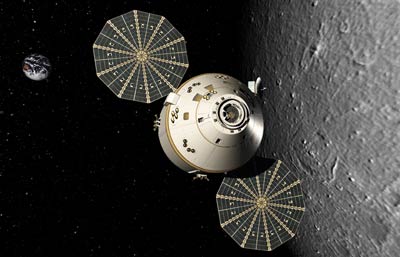Mike Griffin’s greatest mistakeby Taylor Dinerman
|
| A far better justification for Constellation would have revolved around the need for an American Soyuz. |
For most Americans the Apollo Moon missions were a shining success, an example of Americans joining together and accomplishing something that no other nation could. In the context of the Cold War it was an amazing victory at a time when US prestige and influence were at an all-time lows thanks to Vietnam and, beginning in 1972, Watergate. The pictures of Buzz Aldrin and the other astronauts standing next to the flag have become as iconic as the pictures of Washington crossing the Delaware or of the Marines raising the flag on Iwo Jima.
Yet there has always been a persistent and influential group of naysayers. For some it was a waste of money that would have been better spent on social programs or foreign aid, and for others it was a gigantic socialist program that created a huge roadblock to the privatization of space exploration. Whatever the reason, by invoking Apollo, Griffin revived and energized a deep resentment on the part of many individuals who have long resented the nature and the direction of US space policy.
A far better justification for Constellation would have revolved around the need for an American Soyuz. After all, the most successful—and somewhat profitable—human space transportation system is this Russian one. Based on Sergei Korolev’s original R-7 design, the Soyuz booster with its characteristic multiple four-nozzle LOX/kerosene engines has been the object of a long series of modest but incremental improvements over the last half-century. Today, there is no question that it remains an outstanding space transportation system.
It may be worth mentioning that it is not the only aerospace product that has survived from that era. The Lockheed C-130 transport has been in production for even longer. Like the Soyuz it has been continuously improved and is likely to remain in production for at least another decade and in use far beyond that.
The 2005 Exploration Systems Architecture Study (ESAS) “concluded that the safest, most reliable, and most affordable means of meeting space station crew and cargo requirements is a system derived from the current Space Shuttle solid rocket booster (SRB) and liquid propulsion system.” This conclusion was later modified and the Space Shuttle main engine was dropped as the upper stage engine, but NASA remained committed to the SRBs as a first stage. While Griffin made several attempts to justify this choice, he never was able to convince his many critics.
| If allowed to go forward, Ares 1 has the potential, over the long term, to be America’s answer to Soyuz, a system that can launch on time and within budget. |
In fact the case for the SRBs was and remains a strong one. They have been in development and use since the early 1970s when the Shuttle was conceived (like all major space systems, in sin). Since 1981 it has flown 260 times (two boosters on each of 130 shuttle flights) with one catastrophic failure in 1986. It has been the object of constant small improvements and is serviced by a cadre of experienced men and women whose expertise would be thrown away if the plan to destroy Constellation is carried out.
There is no doubt that, as of now, a system based on the SRBs would be the safest and most reliable option to replace the Shuttle. Alternatives such as the Atlas 5 or another commercial launcher simply lack a comparable record. By the end of this decade it is almost certain that some of the newer rockets will have established themselves, but a decade-long gap in the ability of America to safely launch humans into space will be something this country will be ashamed of.
If allowed to go forward, Ares 1 has the potential, over the long term, to be America’s answer to Soyuz, a system that can launch on time and within budget. Every subsystem on it has been and will be subject to a continual process of improvement. Unlike the Saturn V, which only flew 13 times, the Ares 1 has the real potential to fly hundreds of missions safely and reliably. Like Soyuz it may even have the potential to launch private citizens into orbit and beyond.
As the debate over the future of America’s space industry and space program unfolds, it is inevitable to all sides will seek to use the example of Apollo to buttress their arguments. It would perhaps have been better for all concerned if Mike Griffin had been a bit more careful in his use of analogies.
